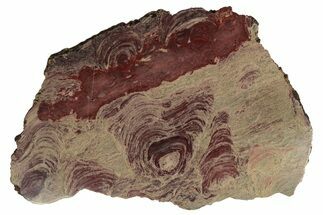This Specimen has been sold.
Isua Banded Iron From Greenland - Earliest Known Evidence of Life
This is an fascinating 2.1" wide, polished slab of Isua Banded Iron from Southwestern Greenland. Recently exposed by melting glaciers, these rocks from the Isua Greenstone Belt are not only the oldest rocks exposed on earth's surface but studies in 2016 have concluded they also harbor the first evidence of life on earth, 3.7 billion years ago. Due to the remoteness of the locality the material available is pretty limited and was only able to acquire a handful of pieces.
From Wikipedia
In August 2016, an Australia-based research team presented evidence that the Isua Greenstone Belt contains the remains of stromatolite microbial colonies that formed approximately 3.7 billion years ago. These remains predate the oldest previously known stromatolite remains, found in the Dresser Formation in western Australia, by 220 million years.
The complexity of the stromatolites found at Isua suggest that life on Earth was already sophisticated and robust by the time of their formation, and that the earliest life on Earth likely evolved over 4 billion years ago. This conclusion is supported in part by the instability of Earth's surface conditions 3.7 billion years ago, which included intense asteroid bombardment.The formation and preservation of fossils from this period indicate that life evolved early and prolifically in Earth's history.
The stromatolite fossils appear wavy and dome-shaped, are typically 1–4 cm (0.4–1.6 in) high, and were found in iron- and magnesium-rich dolomite sedimentary rocks that had recently been exposed by melting snow. The surrounding rocks suggest that the stromatolites lived and were deposited in a shallow marine environment. While most rocks in the Isua Greenstone Belt are too metamorphically altered to preserve fossils, the area of stromatolite discovery has preserved original sedimentary rocks, and the fossils inside them.
The ISB sedimentary layers containing the stromatolites overlay volcanic rocks that are dated to 3.709 billion years old, and are capped by dolomite sediments and banded iron formations with thorium-uranium zircons dated to 3.695 ± 0.4 billion years old. All layers, including those bordering the stromatolites, experienced metamorphism and deformation after deposition, and temperatures not exceeding 550 °C (1,000 °F).
The identity of the ISB features as stromatolites is controversial, because similar features may form through non-biological processes. However, apparent sand accumulation against the sides of the putative stromatolites during their formation suggest that observed, dome-like features arose during the sedimentary process, and not through later, metamorphic deformation. This suggests the features are fossils of ancient stromatolites.
From Wikipedia
In August 2016, an Australia-based research team presented evidence that the Isua Greenstone Belt contains the remains of stromatolite microbial colonies that formed approximately 3.7 billion years ago. These remains predate the oldest previously known stromatolite remains, found in the Dresser Formation in western Australia, by 220 million years.
The complexity of the stromatolites found at Isua suggest that life on Earth was already sophisticated and robust by the time of their formation, and that the earliest life on Earth likely evolved over 4 billion years ago. This conclusion is supported in part by the instability of Earth's surface conditions 3.7 billion years ago, which included intense asteroid bombardment.The formation and preservation of fossils from this period indicate that life evolved early and prolifically in Earth's history.
The stromatolite fossils appear wavy and dome-shaped, are typically 1–4 cm (0.4–1.6 in) high, and were found in iron- and magnesium-rich dolomite sedimentary rocks that had recently been exposed by melting snow. The surrounding rocks suggest that the stromatolites lived and were deposited in a shallow marine environment. While most rocks in the Isua Greenstone Belt are too metamorphically altered to preserve fossils, the area of stromatolite discovery has preserved original sedimentary rocks, and the fossils inside them.
The ISB sedimentary layers containing the stromatolites overlay volcanic rocks that are dated to 3.709 billion years old, and are capped by dolomite sediments and banded iron formations with thorium-uranium zircons dated to 3.695 ± 0.4 billion years old. All layers, including those bordering the stromatolites, experienced metamorphism and deformation after deposition, and temperatures not exceeding 550 °C (1,000 °F).
The identity of the ISB features as stromatolites is controversial, because similar features may form through non-biological processes. However, apparent sand accumulation against the sides of the putative stromatolites during their formation suggest that observed, dome-like features arose during the sedimentary process, and not through later, metamorphic deformation. This suggests the features are fossils of ancient stromatolites.
SPECIES
Isua Banded Iron
LOCATION
Southwest Greenland
FORMATION
Isua Supracrustal Belt
SIZE
2.1" wide, 1.5" tall, 1/2" thick
CATEGORY
ITEM
#62768
We guarantee the authenticity of all of our specimens.
 Reviews
Reviews











